The former NSW Supreme Court defamation judge David Levine died on May 11 at the age of 75 ... The Gazette pays tribute to him with a collection of memories from friends and colleagues ... Contributions from Tom Blackburn SC, Richard Coleman, Judith White, Judge Judith Gibson, Peter Semmler QC, Robyn Ayres, Sophie Dawson and Jim Micallef
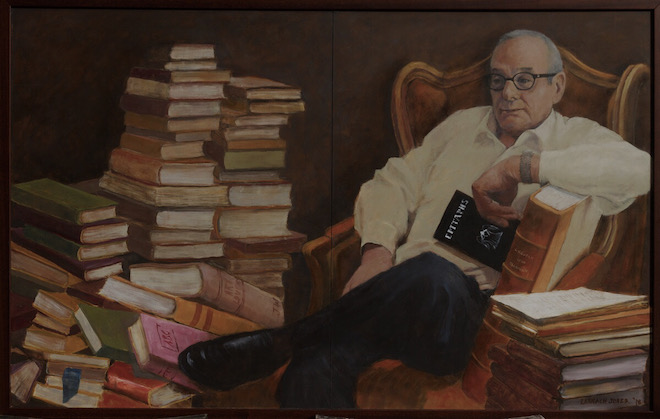 Portrait of David Levine by Mary Larnach-Jones
Portrait of David Levine by Mary Larnach-Jones
Tom Blackburn SC
Tom Blackburn is at the bar in Sydney and London
When Justice Levine took over the defamation list in the 1990s, he knew exactly what needed to be done. In a speech to university students (preserved in the Attorney’s second reading speech at the time of the introduction of the 2005 Defamation Act), his Honour spoke of “the excruciating and sterile technicalities” which were a consequence of the imputation being the cause of action. He added:
“The amount of the court’s time, let alone litigants’ resources, expended profligately in the determination of what words, sentences and phrases mean is positively scandalous: and this is at the initiation of proceedings … Matters of principle have been elevated to an obsessive preoccupation, the playthings of forensic ingenuity, fantasy and imagination at the expense of the early, quick and cheap litigation of real issues that affect the people involved in libel actions …”
Justice Michael Kirby, when President of the Court of Appeal, observed (in dissent) in ABC v Drummoyne Municipal Council (1991):
“Defamation procedure, including pre-trial application of the kind with which Hunt J was dealing here, have become unduly and unnecessarily complex. With complexity comes delay and expense outweighing by the utility gained. A plaintiff who alleges that it has been defamed must run a gauntlet of interlocutory proceedings of the kind which, sadly, are illustrated by the numerous skirmishes in Hepburn, the repeated reports of other cases and the proceedings in the instant case. The result may be satisfactory to most lawyers who specialise in the Defamation List. It cannot but be discouraging to a plaintiff with a legitimate complaint forced into a system of interlocutory hearings which may occasionally even be used to exhaust or discourage those on the receiving end of defamation.”
Majorities and precedent were against their Honours, even after 2005 when the imputation ceased to be the cause of action. But Justice Levine (and Justice Kirby) were, with respect, ahead of their time. Cases in the courts of states which rejected the New South Wales approach proceeded all the while to their satisfactory conclusions without exquisite arguments about precision in imputations.
The Federal Court, where much defamation litigation in New South Wales is now heard, has strongly discouraged interlocutory skirmishes about capacity and meaning.
In England and Wales, capacity arguments were consigned to the dustbin years ago, and preliminary trials on meaning as a matter of fact are common, thus isolating the real issues to be tried on the defence (though it must be added that this is possible because jury trials have virtually been abolished).
It’s impossible not to feel deep sadness at David Levine’s death. For those who knew him, and who appeared before him, that sadness is made more acute by deep affection. He had a natural and unaffected dignity on the bench and lost absolutely no authority by being a gentle and pleasant audience. If counsel made an unmeritorious submission, the rebuke was always courteous and concise — and it hit home all the more strongly.
He was a master of the law of defamation. He saw through its occasional absurdities, and always endeavoured to circumvent them consistently with authority.
His service to the community was recognised by his admission to membership of the Order of Australia in 2010, and earlier with a Reserve Forces Decoration.
I had the good fortune to have dinner with him last December at his home in Paddington. He had an oxygen cannula under his nose, and he was tended and fussed over wonderfully by Agnes his wife. Despite his disability, he and Agnes were as ever the charming and good-humoured hosts, full of amusing anecdotes, interesting conversation and pithy remarks.
And David was enormously proud of his three children. They, his family, and all of us who knew him, have the comfort of a store of happy memories.
• • •
Richard Coleman
Richard Coleman was the Fairfax night lawyer from 1993 to 2017
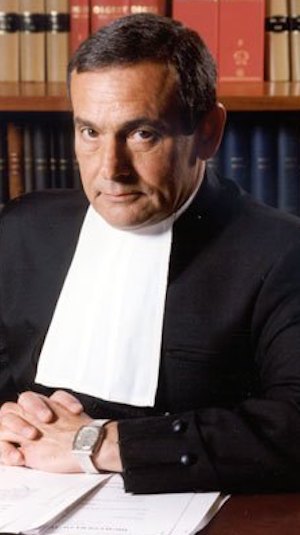 Levine the YoungerThe shortest of short straws on the NSW Supreme Court has to be the appointment as Defamation List judge.
Levine the YoungerThe shortest of short straws on the NSW Supreme Court has to be the appointment as Defamation List judge.
David Levine drew that short straw not long after he switched benches from the District Court to the Supreme Court in 1992. He was well qualified for the post as he had had a busy defamation practice in the 70s and 80s as Fairfax’s defamation junior counsel of choice.
He inherited the defamation list from the imposing Justice David Hunt, who had an inexplicable fascination with the abstruseness of defamation law and who seemed to some to have turned the list into a school for pleading.
Justice Levine found his new job excruciating, as he freely admitted in a speech he gave in 1999:
“Fortnight after fortnight I have to deal with arguments concerning whether a pleaded imputation is proper in form and is capable of arising from the relevant publication. The vocabulary of the Defamation List now includes words used with increasing frequency: ‘Jesuitical, casuistry, weasel words’ and the best of all, ‘epexegetical’.”
Everything was in dispute. I remember one list when he stood a matter down so the two barristers, both experienced, could go outside to work out a timetable only for them to return 30 minutes later, flushed of gill, to say they couldn’t agree and would he mind drafting a timetable for them. His courtroom sangfroid was often sorely tested.
If he ever drew satisfaction from doling out publisher’s loot to a teary-eyed plaintiff, thankfully he never gave an interview about it. Despite his best inclinations, though, he never managed to reduce the excruciations of the list. But he did shake up its case management.
Publishers were alarmed in 1998 to receive a note from Justice Levine to say he intended to have a callover of dormant defamation cases. This was not good news. There were scores of dormant cases. In the late 80s at Fairfax, a new action had arrived nearly every week. But of those, only one or two percent ever made it to a contested hearing. Some settled, but the majority simply became inactive and then slipped into a deep coma somewhere on a shelf in the Supreme Court’s archive.
So in May, he held his two-day callover of 252 dormant cases. It was an extraordinary event. Some of the matters had been inactive for 25 years. One solicitor said his 14 clients, by then quite elderly, had been “traumatised” by the revival of their 1988 case. Other plaintiffs had died. Law firms had disintegrated. Files had been burnt. Companies had gone into liquidation. Nations had collapsed.
The defendant in a 1990 case was the USSR State Committee for Television and Radio Broadcasting. Not surprisingly there was no appearance for that defendant as the USSR had collapsed seven years before. Nevertheless, the judge had the matter called three times outside by the court officer:
“The USSR State Committee for Television and Radio Broadcasting, Court 10A please. The USSR State Committee for Television and Radio Broadcasting, Court 10A please. The USSR State Committee for Television and Radio Broadcasting.”
“No appearance, Your Honour.”
His Honour’s droll reply was: “Does it have another name now? I just ask out of curiosity.”
The result of this new approach to case management meant there was a mini tsunami of revived actions to be defended. And from then on, once they commenced proceedings, plaintiffs were prodded relentlessly to keep their actions going. Legal costs for defendants blossomed alarmingly.
At his retirement from the bench in 2005 there was a warm farewell dinner at Tattersalls attended by the great and not so great of Sydney’s defamation industry. His friend Alex Mitchell, journalist and author, told the story of Justice Levine’s tattoo, having first prudently obtained clearance from Mrs Levine.
The judge had been on circuit in northern NSW when all the cases in front of him were suddenly unable to proceed, leaving him with a free Friday afternoon. So he went to lunch with his tippy in Byron Bay. Such was the liberating vibe of the free afternoon, the beauty of the meal, the wine, the bay and the company, that the judge decided on the spot to cross the road to a tattoo parlour to be inked with the scales of justice. And he was.
A couple of years later, The Australian Financial Review was writing a story about Justice Levine and received information (from me) about the scales of justice tattoo on the bum which was duly published.
The following day a letter on imposing letterhead, bristling with his AO, RFD and QC, arrived at the AFR. The AFR, not well pleased with the bum steer from its legal adviser, nevertheless published the letter immediately. It read:
“I deny absolutely that I have a ‘scales of justice’ tattoo bravely sported on my buttocks. It is bravely, and indeed proudly, sported elsewhere. It is not for me, however, to disclose that it is a discreet and tasteful adornment barely seen behind my left shoulder.”
Good one, Judge.
• • •
Judith White
Judith White, former executive director of the Art Gallery Society of NSW
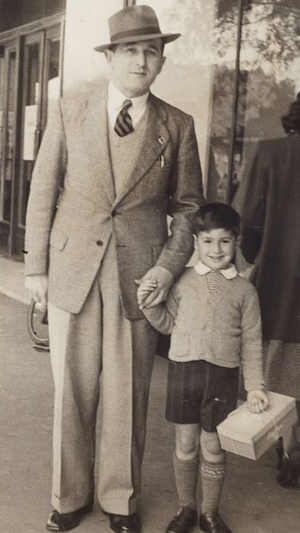 David Levine, 5, with his father Aaron - shopping for shoes at David JonesDavid Levine QC was renowned for his brilliant legal mind, firm principles and ready wit. Less well known is his lifelong support for the arts.
David Levine, 5, with his father Aaron - shopping for shoes at David JonesDavid Levine QC was renowned for his brilliant legal mind, firm principles and ready wit. Less well known is his lifelong support for the arts.
It was my good fortune to get to know him when he served on the Council of the Art Gallery Society of NSW from 2005 to 2014. He had been a member since 1958, when his parents – Justice Aaron Levine and his wife Libbie, a former violinist with the Sydney Symphony Orchestra – gave their schoolboy son his own membership.
Theirs was a household that treasured the arts. The family visited the Art Gallery several times a year, the artist William Dobell was a family friend, and the young David and his sister were keen listeners to the art component of The Argonauts on ABC Radio.
“Like my parents,” he wrote in 2017, “I consider public museums, galleries and libraries to be essential components of civilised life.”
A bibliophile whose Paddington home was lined floor to ceiling with books, he also joined the Friends of the State Library, of which he became chairman, and was a generous patron of the Library’s Foundation.
He believed in friends’ organisations as a fine means of community support for what is “good, beautiful and for all”; and he deplored the vulgarisation of great cultural centres by the tendency of Treasury departments to turn them into what he termed “self-financing profit centres”.
We became allies in opposing the corporatisation of the Art Gallery and the diminution of the role of its Society. To attend meetings with him was rather like being in his court. With his eyes cast to the heavens, he would listen to people blathering on, and then the head would come down, the arm would be raised and he would intervene with such clarity that the argument was closed.
David and his wife Agnes were incomparable dining companions, convivial, insightful and effortlessly amusing.
There was a memorable lunch at Susie Carleton’s Bellevue Hotel when Marcel Berlins, the British lawyer and legal journalist was in town with his American-born wife Lisa Forrell. The conversation turned to international politics, and at a certain point Lisa asked the assembled company: “What happened in Australia after September 11?”
There was a characteristic pause from David, and then he just said: “September 12.”
We shall miss him enormously.
• • •
Judge Judith Gibson
District Court of NSW defamation list judge
The Hon. Justice David Daniel Levine AO RFD QC, who died on May 11, 2020, was a distinguished member of the judiciary in the District Court (1987-1992) and Supreme Court (1992-2005) of New South Wales.
He was, however, so much more as well.
David was born on October 12, 1944 – the son of Judge Aaron Levine (District Court of New South Wales) and his wife Libbie. An important part of his childhood was listening to his father talk about trials and courtroom tactics, as he revealed to the Gazette in a 2005 interview.
As is noted in that interview, Judge Aaron Levine was a distinguished jurist whose rulings on abortion legislation effectively put an end to these controversial and distressing trials (probably as much to the relief of police as to the emerging women’s movement).
As was to be expected from a family where his parents had enrolled him in the Art Gallery Society when he was old enough to be taken to galleries, David had a vast knowledge of the arts and of literature. He was also one of Australia’s most renowned book collectors.
David studied classics as well as law at the University of Sydney. He shared both his knowledge and his management skills with many artistic and literary bodies over the course of his career, notably the Arts Law Centre, as well as holding positions such as the Chairman of the Friends of the State Library of NSW, Governor of the Nicholson Museum and Councillor of the Art Gallery Society of NSW.
My association with him arose from the period when he was the Supreme Court Defamation List Judge, a position he occupied shortly after his transfer to that court in 1992 until a few years before his retirement, in 2005.
David Levine’s judgments on complex issues were works of great scholarship – in particular Sattin v Nationwide News Pty Ltd and Cumberland v Clark stand out.
Even in more mundane matters, he was always able to balance the complexity of the law with simplicity of language. As the Defamation List Judge, he used case management skills well before the maxim “just, quick and cheap” had been coined.
His analysis of abuse of process in Gill v Eatts shows he was one of the few to foresee current concerns for the need for proportionality; it is a judgment that other judges should envy.
He was just as much at home with the ridiculous as with the sublime – which was just as well, as he was called upon to deal with a spate of “ridiculous light” cases after the footballer Andrew Ettingshausen successfully complained about a shower photo.
He summarily disposed of another footballer’s complaint in Coleman v John Fairfax Publications Pty Ltd after a newspaper satire suggested poor footballing could be due to early maternal deprivation issues – “Coleman’s mother blamed for Souths’ disastrous year”.
He was, however, more understanding towards the lawyer who complained when her law firm’s advertisement was gratuitously adorned by a newspaper editor with the cartoon of a vulture.
At times, David was able to call on his considerable knowledge of art history and design in this onslaught of “ridiculous” rulings. In Beck v Nationwide News Pty Ltd, the plaintiff, a sculptor, sued after his proposal to attach a giant sculpture (“An Ode to Magnificent Australian Womanhood”) to the Harbour Bridge for the 2000 Olympics was decried as “sexist and embarrassing”.
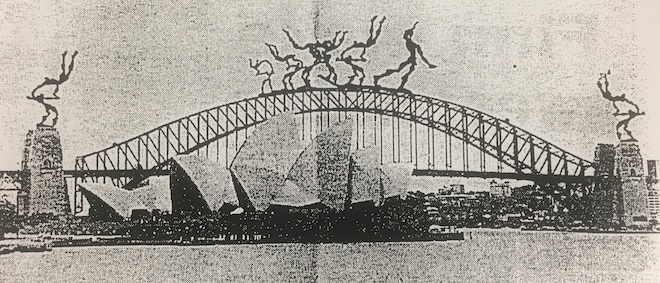 From Beck v Nationwide News
From Beck v Nationwide News
Opining that “this is pre-eminently a jury case”, his Honour refused to strike out the imputations; however, by attaching a photo-montage of the impact of this startling sculpture, he allowed the artwork to speak for itself.
One case which received wide publicity was Falkenberg v Nationwide News Pty Ltd. The plaintiff sued over a Gary Larson “Far Side” cartoon of “Graffiti in Hell”, which depicted the devil writing graffiti consisting of: “For a pleasant conversation call Satan 5551232”.
How was that defamatory? Unfortunately, this telephone number was also the plaintiff’s telephone number, so he had a devilish lot of phone calls.
With the assistance of Clive Evatt, imputations that the plaintiff was “evil” and “an evil fiend” were pleaded. David Levine struck the claim out, but tempered justice with mercy by noting it was almost Christmas and calling (successfully) on the defendant to show the true spirit of the times in relation to costs.
No wonder his popularity with the profession (and with journalists) was legendary; a dinner the profession held for him after his retirement was packed to the rafters.
As a trial judge, David Levine had no peer. This related to every aspect of his role as a judge, from his encouragement of young practitioners to the patience he exhibited during the dozen appeals to the Court of Appeal which interrupted – but only temporarily – his unappellably (in my view) correct conduct of the John Marsden defamation trial.
 Before a parliamentary committeeHis generosity to judicial colleagues was endless – despite his workload, he found time to write a manual for the District Court (on how to deal with section 7A jury trials) that judges still ask me for.
Before a parliamentary committeeHis generosity to judicial colleagues was endless – despite his workload, he found time to write a manual for the District Court (on how to deal with section 7A jury trials) that judges still ask me for.
Some of his jury trials (e.g. Crampton v Nugawela and the “Mr Bubbles” trials) were exceptionally difficult. He brought those same trial skills to these as to the many criminal trials he presided over, both in the District and Supreme Courts.
Although he purported to retire, he took on so many other jobs – ranging from President of the Blackhawk 221 Board of Inquiry to the Chair of the Serious Offenders Review Council to Inspector of the PIC and the ICAC.
Over the past year, as his health declined, he remained a sparkling and witty correspondent, always interested in hearing from me about what he termed “the latest defo reform proposal” and cases of interest.
David could not have been the great judge he was without the assistance of the many talented associates who worked with him over the years, as well as the support and wise counsel of his wife Agnes.
He remained on warm terms with all of his associates.
I did not meet them all, but I would like to mention his District Court associate, Kris Veenstra (who went on to clerk for defamation barristers on 13th Floor St James Hall) and Anita Rogers, who was his associate for much of the 1990s.
• • •
Peter Semmler QC
Peter Semmler is a Sydney barrister
My first encounter with David Levine in his role as a Supreme Court judge was in the early 1990s.
I appeared before him in a test case for hundreds of men who alleged they had been sexually and physically abused by members of the Christian Brothers Order in several Western Australian orphanages decades earlier.
Although the case was ultimately settled, David case managed it for several years. He heard and decided a number of critical interlocutory applications.
It was difficult and emotionally-charged litigation. David handled it with characteristic aplomb. While always quintessentially judicial and irreproachable, he managed to convey a genuine concern, indeed compassion, for these terribly psychiatrically-damaged plaintiffs.
Most importantly, because he was such a fine lawyer he reached the right results on the applications he heard, and thereby facilitated the ultimate settlement.
In more recent years I got to know David better as a fellow member of a book club which included his former colleague on the bench, David Kirby QC, as well as Bernie Gross QC who was my opponent in the Christian Brothers litigation.
David was a man of extraordinary erudition. He was astonishingly well-read. He was an avid, indeed insatiable, collector of books. His ever-expanding library threatened to engulf his Paddington residence.
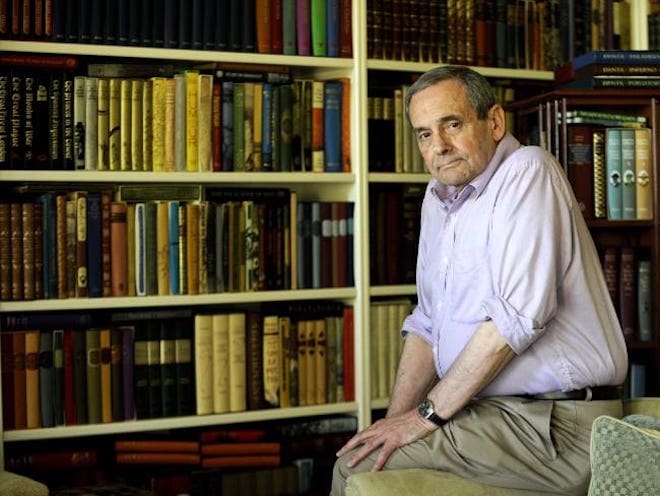 The well-read collector
The well-read collector
His interests ranged widely from the arts to history, politics, baseball and beyond.
While he had firm views about most things, which he was not shy about sharing, these were infused with a conciliatory and infectious sense of humour.
This ensured that the animated discussions at our book club meetings always ended amicably.
His contributions in so many areas will be sorely missed.
• • •
Robyn Ayres
CEO Arts Law Centre of Australia
When I arrived as the new Executive Director of the Arts Law Centre of Australia in 2002, David Levine was my new boss. He was Arts Law’s President and had been in the role since 1995. He was also a serving judge of the Supreme Court of NSW so I anticipated the bar would be high.
Arts Law had been without an ED for six months so there was a lot to do but David allowed me the time and space to find my feet whilst making it clear that the Centre needed stability, a strong sense of direction, and that building strong relationships with stakeholders, including our funders, were priorities.
Whilst astutely aware of Arts Law’s dependence on Government support, David was also fiercely protective of our independence, and given the great services Arts Law provided, that they (the funders) should not be meddling in our business.
No doubt David was mindful of the spreading tentacles of corporatisation in the arts and did not want Arts Law to succumb. His acerbic sense of humour, particularly about the funding landscape, still makes me smile today.
David continued to serve as Arts Law’s President until the end of 2004, stepping down around the same time he retired as a judge from the Supreme Court.
David was a passionate supporter of the arts and understood that Arts Law enabled the arts to flourish. In addition to his service to Arts Law, David served on board of the Art Gallery Society (which supports the Art Gallery of NSW) for nine years.
In 2016 he weighed into the stoush between the members’ society and the gallery management. But I remember he gave me a treasured tip when I first arrived back in town, that as a member of the Art Gallery Society, I could enjoy special private members’ viewing times and miss the hoards at very popular exhibitions.
In 2004, David’s last year on the board, the centre celebrated its 20thanniversary with a soiree at the Art Gallery of NSW. It was a wonderful event for David to preside over and on the night he announced the establishment of Arts Law’s council of patrons which was comprised of leading artists and legal luminaries who had been involved with Arts Law.
I think it was David who suggested that his favourite gypsy band, Monsieur Camembert, play on the night.
David was a supporter of freedom of expression and keen for Arts Law to play an advocacy role to ensure that the arts community had a voice when those freedoms were challenged, a role Arts Law still adheres to today. His support for Arts Law continued long after he retired as our president.
When the defamation laws in NSW changed he even offered to draft a new information sheet for the centre reflecting the changes. David also provided generous financial support through our Guardian Angels program, knowing that philanthropic support not only helped to maintain services, but also our independence.
The Hon David Levine AO RFD QC will be very much missed by Arts Law and the wider arts community and our thoughts are with his family and friends.
• • •
Sophie Dawson
Partner, Bird & Bird
I am sad to hear about the death of Justice Levine.
Justice Levine was not just a great defamation judge, he was a thoroughly decent person.
For those of us who started out as defamation lawyers during his reign as defamation list judge, we were grateful not only for his wisdom but also his good humour.
I experienced this on my very first appearance in the defamation list which was in the mid-1990s.
Clive Evatt was in one of my matters and started tapping me on the shoulder when I was on my feet in the middle of discovery submissions. I was not sure at the time quite what to do. Justice Levine said:
“Ms Dawson, if you wish to appear in this list, then you will need to learn to ignore Mr Evatt.”
Sage advice.
It is a pity that each of them has gone. Justice Levine listened with respect to those early, inexperienced, submissions by me and by others.
The atmosphere he created in his courtroom was not only one of fairness and dignity, but of collegiality and kindness.
A good example for all of us in our respective workplaces. My thoughts go to his family.
• • •
Jim Micallef
Special Counsel, Corrs Chambers Westgarth
I was very fortunate to be David’s associate for over four years, first in the NSW District Court (January 1990 to July 1992) and then in the NSW Supreme Court (August 1992 to June 1994).
I can still remember the first time I met David during an interview in the old King Street complex where David had his chambers and thinking I was in the presence of God. He had that awe about him.
Of course, that changed over time, as I learnt that he was as human as the rest of us. Surprisingly shy but with a great sense of humour and needless to say, humble notwithstanding his great intellect.
David was also extraordinarily generous in every respect. There was hardly a case that he didn’t call me into chambers to chat about the law, the facts or the advocacy.
He would speak about the importance of the rule of law and, notwithstanding the plaque on his desk smouldering in cigarette smoke that said, “Spare me the details, just the facts”, he rarely pulled counsel up, even if they did tend to ramble on.
As for advocacy, I can to this day remember him dissecting the brilliance of Tom Hughes during the second Carson trial with the jury, and indeed everyone in court, completely mesmerised; or in proclaiming Virginia Bell’s closing address to a jury in a murder trial as a nothing short of a masterpiece.
My fondest memories of working with David was when we went on country circuits around the State, to Broken Hill, Lismore and many other places. We would often go to the local club to, in David’s words, “contribute to the local community” by having a meal and playing the pokies – not those fancy things you see in clubs today but the one-arm bandits. It was David’s way of switching off.
We would head off on trips to Silverton or Nimbin, to the cotton farms in Moree or the wineries in Rutherglen. Indeed, I first saw the Menindee Lakes with David on a circuit to Broken Hill.
I can still remember him, with no water in sight, pulling over near a bund on the side of the road in the middle of nowhere. He just knew the joy I would get from the surprise of seeing the wide expanse of water from the top of the bund.
Working with David, you could not help but be educated about the law of defamation and to understand what he described as its pursuit of a balance between freedom of speech and the protection of reputation.
In this and in many respects, I was very fortunate indeed. I still wonder why David employed me as his associate 30 years ago. I wonder whether it was about David, a man of the people, opening up an opportunity; but it may also have been about breaking down norms in choosing the only male associate then in the District Court.
Whatever the reason, I will be forever grateful.

First published in the Gazette of Law & Journalism